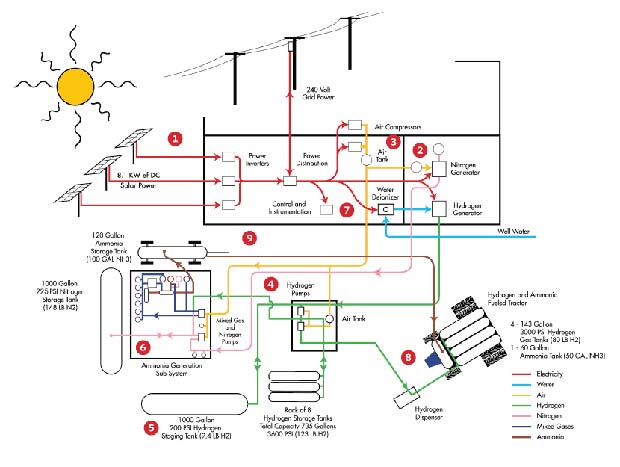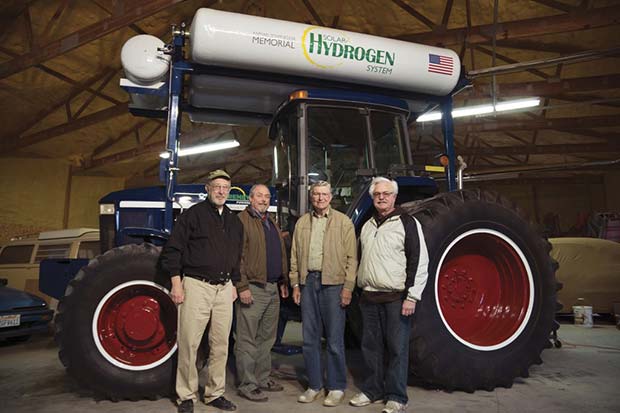A team led by Jay Schmuecker has created a hydrogen-ammonia tractor upon an Iowa farm plus a whole solar system to provide the fuel.
This incredible new system could be a game-changer for everyone. It’s the definition of modern thinking put into a slick renewable system. You can check out a System Schematic drawing of the system itself, and learn about each and every one of its unique and impressive sub-systems.

For example, the whole system is going to run on the use of three two-degree-of-freedom solar trackers, each using 12 solar panels, able to produce a whopping 8.1kW of energy. The daily power available from the panels is roughly enough, but any power that is left over will be fed into the grid.
From the Solar Hydrogen System website: “Dennis was interested in having a tractor that he would use under full power in the field rather than just to drive in parades. Because of the limited hydrogen generated, our hydrogen tractor is capable of being used for 10% of the farm operations.
“I started out assuming that I could obtain a diesel tractor and have it modified to run on hydrogen. Companies are working on having diesels run on hydrogen, but are years away from having a product. New Holland has developed an award-winning fuel cell powered tractor, but the costs of obtaining a tractor powered by fuel cells is prohibitive. We contacted the Hydrogen Engine Center (HEC) in Algona, Iowa, who has been making Internal Combustion Engines that are modified to run on hydrogen gas. They agreed to provide a Ford 460 cu. in. V-8 engine design that could be installed in a tractor and used in the field. We selected and purchased a John Deere 7810 tractor. The four hydrogen tanks are sized to contain enough fuel to operate the tractor at full power for four hours before refueling.”
whole system is capable of producing renewable gas, for example, by using water from a nearby well that flows through a deionizer. This then puts it through a hydrogen generator, and a nitrogen generator, meaning that pure nitrogen can be produced which is flowed directly into the nitrogen pump.
The oxygen is then vented out and the hydrogen will flow into the storage tanks, while the nitrogen will flow into the ammonia shed, where it goes through a compression period and is kept in the nitrogen storage tank.
It’s also got a very impressive hydrogen pump assembly, allowing for a continuous state of production to continue on. With tanks as large as 1000-gallon in size, they can certainly control and maintain a huge amount of the resources currently being produced by the farm.

Of course, no system like this could ever be built without guarantees that it would be safe to spend time around. With the respectful use of their equipment, especially the ammonia, there is an easy way to help maintain and control the whole state of the system. This is one of the many reasons why, for many, this project looks to be one of the most interesting of its kind.
Not only is the whole system so widely and intelligently connected, but it’s made to help deliver the right levels of safety, security and consistency. In a world where we need to see more work done to combat the damage we’ve produced to the environment, green-minded solutions like this very much make sense.
According to Jay Schmuecker, “My late father was an advocate of using hydrogen to replace fossil fuels. Ten years ago I started a project on the Iowa farm where he was born to make demonstration amounts of hydrogen, nitrogen, and ammonia from solar power, water and air. There are no carbon emissions in either the generation or consumption of these elements and fuels. The hydrogen and ammonia are used to fuel my tractor, and the ammonia can be applied as a fertilizer.
“Five years ago I took delivery of my John Deere 7810 tractor in which was installed a Ford 460 V-8 block modified to 9.6 liter with a 13.5 to 1 compression ratio. The hydrogen is injected into the spark ignited cylinders, and the engine will also run on a combination of about 10 % hydrogen and 90% ammonia.
“Ammonia is an excellent hydrogen carrier. As a liquid it can be stored in 200 psi tanks where hydrogen uses 3000 psi or more tanks to store the gas. As with gasoline there are safety concerns with ammonia, Iowa farmers are used to working with ammonia as they apply it to their corn fields as a fertilizer.”
There you have it. I’ve talked about hydrogen fueled tractors before. But this farm tractor and system bring the game to a whole new level.